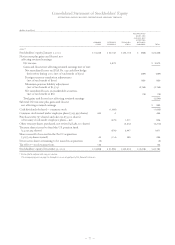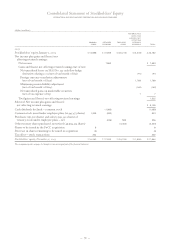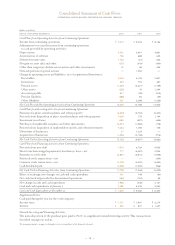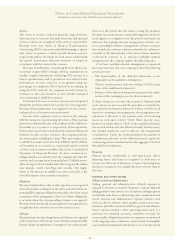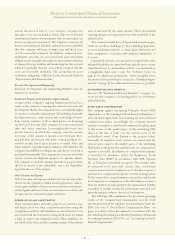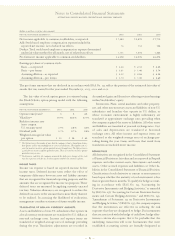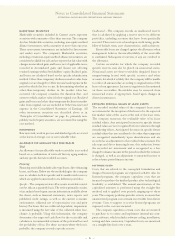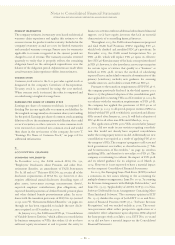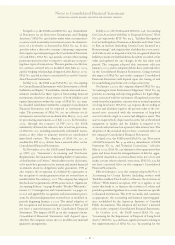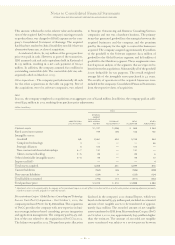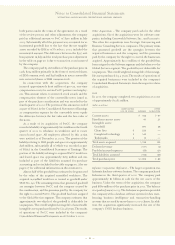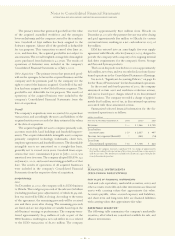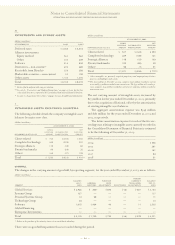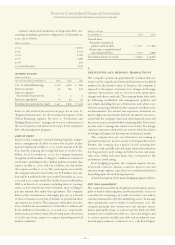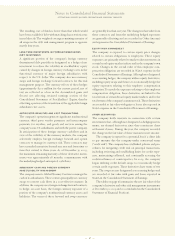IBM 2003 Annual Report Download - page 89
Download and view the complete annual report
Please find page 89 of the 2003 IBM annual report below. You can navigate through the pages in the report by either clicking on the pages listed below, or by using the keyword search tool below to find specific information within the annual report.
In April 2003, the FASB issued SFAS No. 149, “Amendment
of Statement 133 on Derivative Instruments and Hedging
Activities.” SFAS No. 149 clarifies under what circumstances
a contract with an initial net investment meets the character-
istics of a derivative as discussed in SFAS No. 133. It also
specifies when a derivative contains a financing component
that requires special reporting in the Consolidated Statement
of Cash Flows. SFAS No. 149 amends certain other existing
pronouncements in order to improve consistency in report-
ing these types of transactions. The new guidance is effective
for contracts entered into or modified after June 30, 2003,
and for hedging relationships designated after June 30, 2003.
SFAS No. 149 did not have a material effect on the Consoli-
dated Financial Statements.
In May 2003, the FASB issued SFAS No. 150, “Accounting
for Certain Financial Instruments with Characteristics of both
Liabilities and Equity.” It establishes classification and meas-
urement standards for three types of freestanding financial
instruments that have characteristics of both liabilities and
equity. Instruments within the scope of SFAS No. 150 must
be classified as liabilities within the company’s Consolidated
Financial Statements and be reported at settlement date
value. The provisions of SFAS No. 150 are effective for (1)
instruments entered into or modified after May 31, 2003, and
(2) pre-existing instruments as of July 1, 2003. In November
2003, through the issuance of FSP 150-3, the FASB
indefinitely deferred the effective date of certain provisions
of SFAS No. 150, including mandatorily redeemable instru-
ments as they relate to minority interests in consolidated
finite-lived entities. The adoption of SFAS No. 150, as
modified by FSP 150-3, did not have a material effect on the
Consolidated Financial Statements.
In November 2002, the FASB issued Interpretation No.
45 (FIN 45), “Guarantor’s Accounting and Disclosure
Requirements for Guarantees, Including Indirect Guarantees
of Indebtedness of Others,” which addresses the disclosures
to be made by a guarantor in its interim and annual financial
statements about its obligations under guarantees. FIN 45
also requires the recognition of a liability by a guarantor at
the inception of certain guarantees that are entered into or
modified after December 31, 2002. The company has adopted
the disclosure requirements of FIN 45 (see note A, “Significant
Accounting Policies,” on page 86 under “Product Warranties,”
in note O, “Contingencies and Commitments,” on pages 101
to 103) and applied the recognition and measurement provi-
sions for all material guarantees entered into or modified in
periods beginning January 1, 2003. The initial adoption of
the recognition and measurement provisions of FIN 45 did
not have a material impact on the Consolidated Financial
Statements. The impact of FIN 45 on the company’s future
Consolidated Financial Statements will depend upon
whether the company enters into or modifies any material
guarantee arrangements.
In July 2002, the FASB issued SFAS No. 146, “Accounting
for Costs Associated with Exit or Disposal Activities.” SFAS
No. 146 supersedes EITF No. 94-3, “Liability Recognition
for Certain Employee Termination Benefits and Other Costs
to Exit an Activity (Including Certain Costs Incurred in a
Restructuring),” and requires that a liability for a cost associ-
ated with an exit or disposal activity be recognized when the
liability is incurred. Such liabilities should be recorded at fair
value and updated for any changes in the fair value each
period. The company adopted this statement effective
January 1, 2003, and its adoption did not have a material effect
on the Consolidated Financial Statements. Going forward,
the impact of SFAS No. 146 on the company’s Consolidated
Financial Statements will depend upon the timing of and
facts underlying any future exit or disposal activity.
On January 1, 2003, the company adopted SFAS No. 143,
“A ccounting for Asset Retirement Obligations.” SFAS No. 143
provides accounting and reporting guidance for legal obliga-
tions associated with the retirement of long-lived assets that
result from the acquisition, construction or normal operation
of a long-lived asset. SFAS No. 143 requires the recording of
an asset and a liability equal to the present value of the esti-
mated costs associated with the retirement of long-lived
assets for which a legal or contractual obligation exists. The
asset is required to be depreciated over the life of the related
equipment or facility, and the liability is required to be
accreted each year based on a present value interest rate. The
adoption of the standard did not have a material effect on
the company’s Consolidated Financial Statements.
In April 2002, the FASB issued SFAS No. 145, “Rescission
of FASB Statements No. 4, 44 and 64, Amendment of FASB
Statement No. 13, and Technical Corrections,” effective
May 15, 2002. SFAS No. 145 eliminates the requirement that
gains and losses from the extinguishment of debt be aggre-
gated and classified as an extraordinary item, net of tax, and
makes certain other technical corrections. SFAS No. 145 did
not have a material effect on the company’s Consolidated
Financial Statements.
Effective January 1, 2002, the company adopted SOP 01-6,
“A ccounting by Certain Entities (including entities with
Trade Receivables) That Lend to or Finance the Activities of
Others.” With limited exception, SOP 01-6 applies to any
entity that lends to, or finances the activities of, others and
provides specialized guidance for certain transactions specific
to financial institutions. This SOP reconciles and conforms,
as appropriate, the accounting and financial reporting guid-
ance established by the American Institute of Certified
Public Accountants. The adoption did not have a material
effect on the company’s Consolidated Financial Statements.
In October 2001, the FASB issued SFAS No. 144,
“A ccounting for the Impairment or Disposal of Long-Lived
Assets.” SFAS No. 144 addresses significant issues relating to
the implementation of SFAS No. 121, “Accounting for the
Notes to Consolidated Financial Statements
INTERNATIONAL BUSINESS MACHINES CORPORATION AND SUBSIDIARY COMPANIES
87


